South Korea Luxury Residential Real Estate Market Size
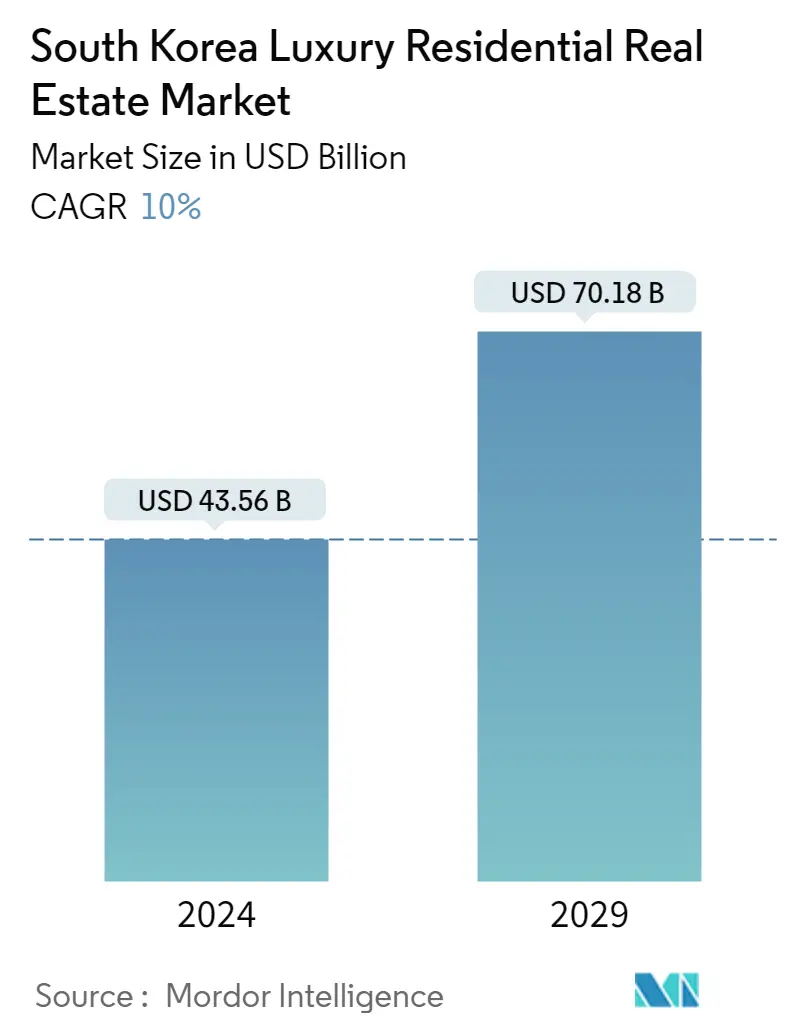
| Study Period | 2019 - 2029 |
| Base Year For Estimation | 2023 |
| Market Size (2024) | USD 43.56 Billion |
| Market Size (2029) | USD 70.18 Billion |
| CAGR (2024 - 2029) | 10.00 % |
| Market Concentration | Low |
Major Players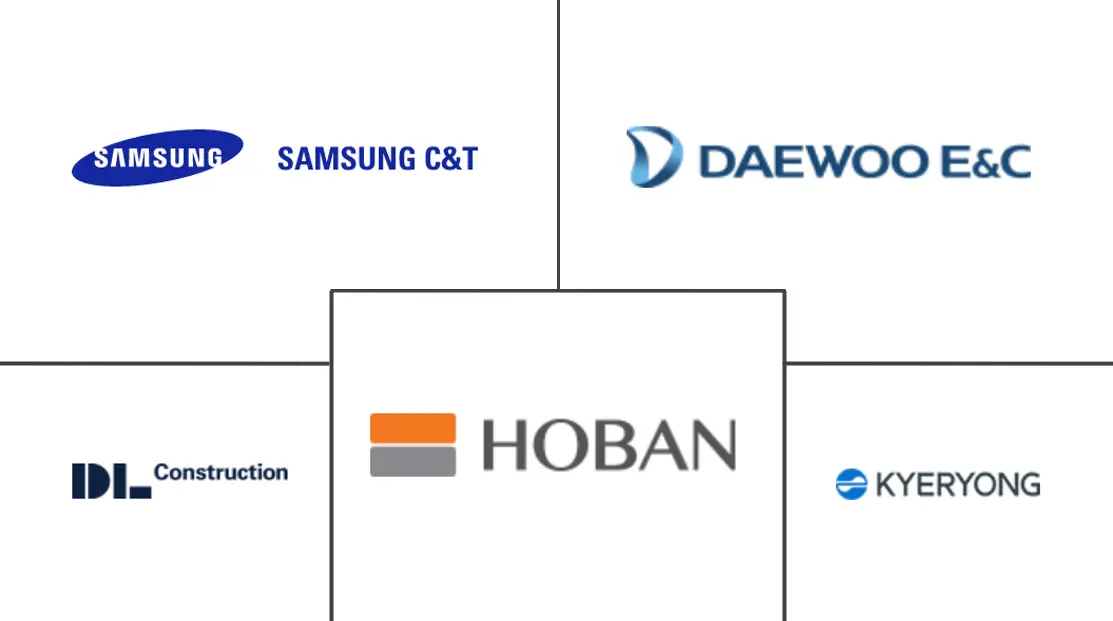
*Disclaimer: Major Players sorted in no particular order |
South Korea Luxury Residential Real Estate Market Analysis
The South Korea Luxury Residential Real Estate Market size is estimated at USD 43.56 billion in 2024, and is expected to reach USD 70.18 billion by 2029, growing at a CAGR of 10% during the forecast period (2024-2029).
- The South Korean luxury residential real estate market is currently pegged at a market value of USD 39.6 billion and USD 63.80 billion in 2028. It is anticipated to register a CAGR of more than 10% over the forecast period.
- The market is driven by luxury real estate development in key cities. Furthermore, demand for apartments is driving the market.
- Property in Gangnam, a trio of upscale neighborhoods in Seoul, South Korea's capital, is starting to sag as the year-long tightening cycle of the central bank pounds on the upscale real estate market. According to Korea Real Estate Board data, apartment prices dropped in all Gangnam districts for four weeks. It portends the first monthly drop since the Bank of Korea started hiking its key rate in August 2022. The attack on Gangnam indicates that the 51 million Koreans living in the upper strata are now feeling the effects of tighter policy. The vast majority of Seoul residences included in the Knight Frank Prime Global Cities Index are Gangnam apartments, which slowed down after increasing quickly since 2008.
- Data from the Korea Real Estate Board showed that house prices in South Korea decreased by 1.98% in December 2022 compared to the previous month. It indicated the steepest loss since data release started in late 2003 and the seventh consecutive month of decline. According to a statement from the board, this represented a 4.68% fall for 2022 after a gain of 9.93% in 2021 and a loss of 1.37% in November. Globally, home values were falling precipitously due to central banks' rapid increases in interest rates to combat inflation. It cooled the economy and increased mortgage rates. According to the data, property prices nationwide fell by 4.89% during the past seven consecutive months, the largest decline for any seven months ever.
- According to statistics released on Monday, the housing market in Seoul entered a phase of stasis as apartment prices, which make up the majority of residential units in the city, are falling. Also, fewer transactions are occurring due to rising loan interest rates. In Seoul, the number of apartment units traded at lower prices than before surpassed the number of flats traded at greater prices, said Zigbang, a local property technology company. According to separate statistics from the Korea Real Estate Board, apartment prices in Seoul decreased by 0.09% last week, the 12th consecutive week of declines. Even Seocho-gu, a highly sought-after residential neighborhood in southern Seoul, defied price drops since the third week of February 2022 and saw trading prices finally fall.
- External factors like rising inflation and increased borrowing costs will keep the housing market and property prices down. However, this is unlikely to cause panic sales by homeowners or a harsh landing for the apartment market. According to analysts, the rising interest rate, which further slows demand for property purchases in Seoul, is one of the main factors holding down apartment prices. Due to the contraction in buying sentiment as the burden of interest rises, the transaction downturn in the apartment market is anticipated to last until the end of this year. Despite the units being offered for less, no housing transactions are happening. That is the amount that Seoul's apartment market shrunk.
South Korea Luxury Residential Real Estate Market Trends
Reduction in prices creating demand for low-priced luxury real estate
Due to recent changes in lending standards and interest rate hikes, South Korea's housing market is slowing down quickly after experiencing a recent surge in home prices. Home prices decreased by 1.46% in Q3 2022 compared to last year's period, a sharp decline from the 17.64% gain in Q3 2021. House prices decreased by 1.48% every quarter in Q3. The recent implementation of market-cooling policies is mostly to blame for the housing market's abrupt slowdown. The Financial Services Commission (FSC) said in December 2021 that it would impose stronger regulations on jeonse loans, a type of home lease in which tenants sign a two-year contract and pay a refundable lump sum deposit instead of monthly rent. Then, in early 2022, banks announced tighter borrower lending guidelines.
For instance, debtors are prohibited from obtaining further loans if their total outstanding debt exceeds KRW 200 million (USD 0.15 Million) and their principal and interest payments amount to more than 40% of their yearly income. To reduce inflationary pressures, the Bank of Korea (BOK) increased its benchmark interest rate by 25 basis points to 3.25% in November 2022. It was the bank's ninth consecutive rate increase since August 2021 and its highest level since June 2011. As a result, overall inflation decreased from 5.7% in October 2022 to 5% in November 2022. In July 2022, inflation rose to a 24-year high of 6.3%.
Many factors point to a severe decline in the property market in Korea, which could lead to a painful landing. As sales declined and the quantity of unsold new flats rose, home values plummeted. Especially worrying is that, despite the region's high-interest rates, price misalignment, and other downside concerns, property values in the country fell more precipitously than those in most other Asia-Pacific nations. The increase in misalignment is primarily responsible for the decline in the housing price at risk. However, momentum effects from good lagged prices partially offset this trend.
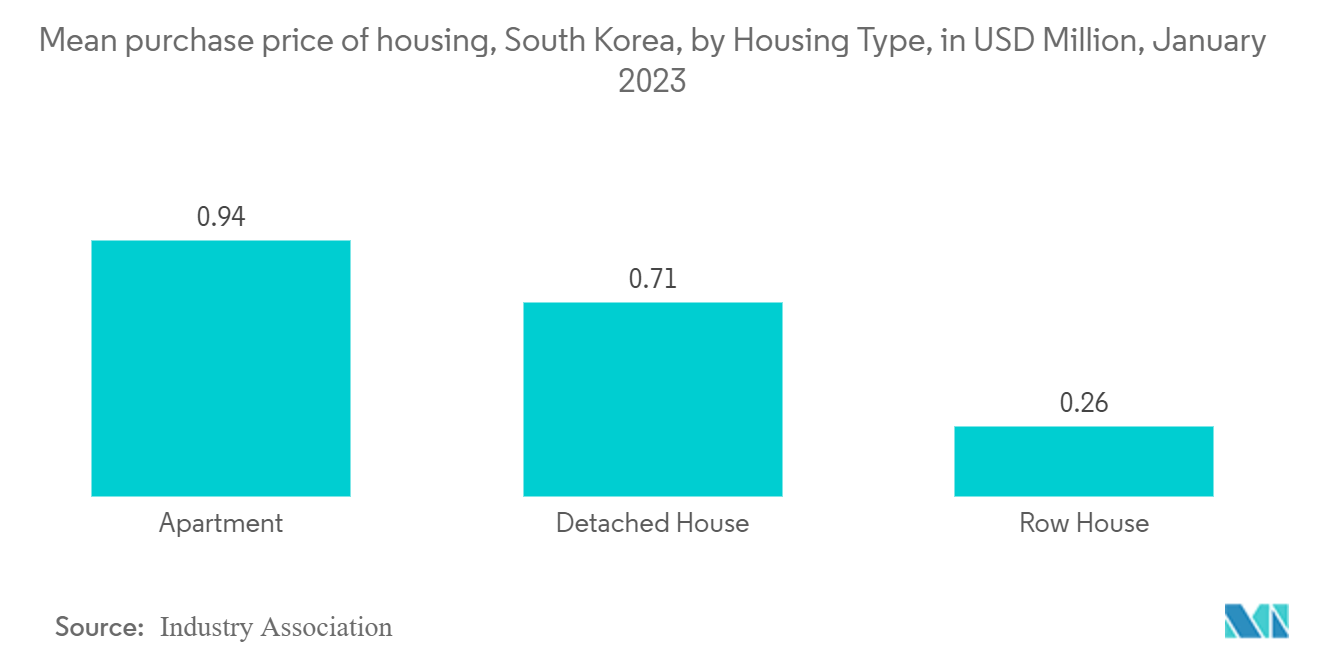
Concentration of Luxury Real Estate in Gangnam District, Seoul
In Seoul's thriving South Korean capital, owning real estate in a sought-after neighborhood signifies material prosperity. The South Korean city is divided into 25 districts, identified by the suffix -gu. Each district is again divided into neighborhoods, frequently identified by the suffix -dong. Each neighborhood and district includes its unique charm and history, but some are more well-known than others. The wealthy congregate in these upscale neighborhoods, including well-known Korean celebrities.
Seoul's Gangnam neighborhood, dubbed the Beverly Hills of South Korea, earned even greater notoriety after the publication of Korean musician Psy's global smash Gangnam Style in 2012. Many celebrities and business tycoons call the posh Cheongdam-dong neighborhood home. The affluent neighborhood, which contains some of the most expensive real estate in the nation, also includes several upmarket restaurants, pubs, galleries, beauty salons, and a stretch of high-end clothing stores. According to reports, celebrities like K-pop soloist and actress IU paid USD 11.7 million for a penthouse apartment in the area. The corporate offices of numerous K-pop management firms, notably SM Entertainment and Cube Entertainment, are located in Cheongdam-dong.
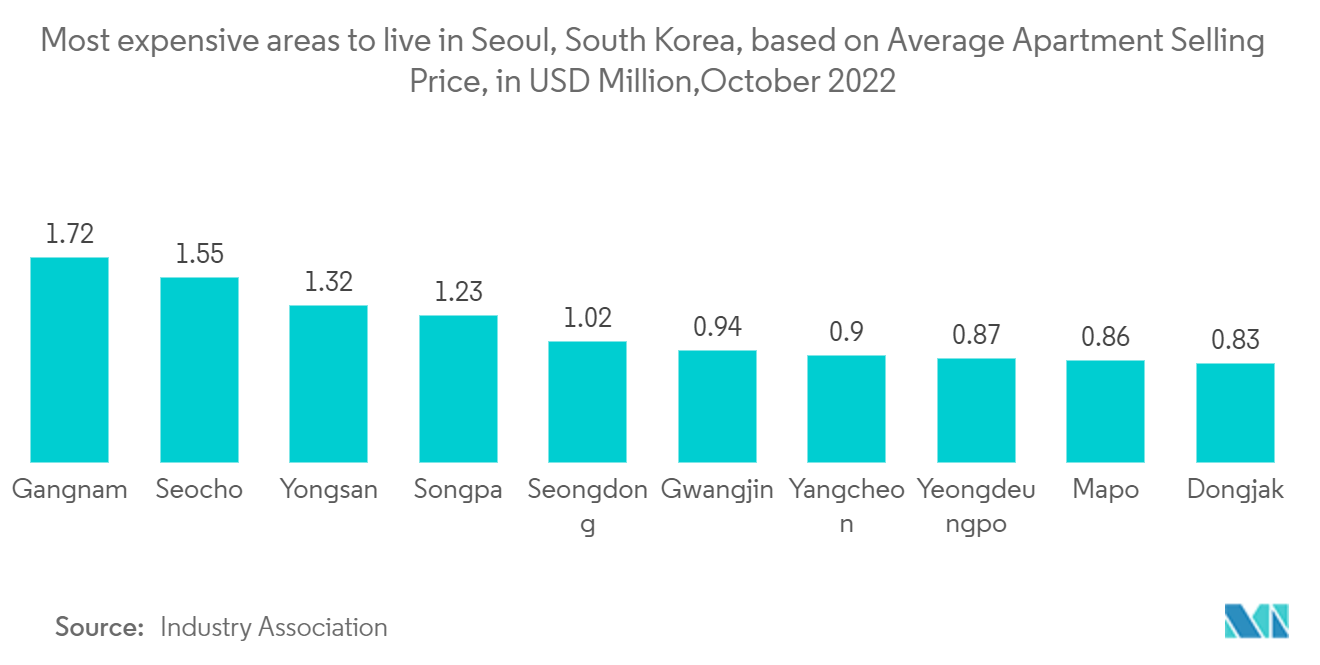
South Korea Luxury Residential Real Estate Industry Overview
The South Korean luxury residential real estate market is fairly fragmented, with local and global players existing in the market. Some of the major players in the market include Samsung C&T Corporation, Daewoo Engineering & Construction, KyeRyong Construction Industrial, Hoban Construction, and DL Construction. Key players in the market are leveraging partnerships, acquisitions, and mergers to capture the market share.
South Korea Luxury Residential Real Estate Market Leaders
-
Samsung C&T Corporation
-
Daewoo Engineering & Construction
-
KyeRyong Construction Industrial
-
Hoban Construction
-
DL Construction
*Disclaimer: Major Players sorted in no particular order
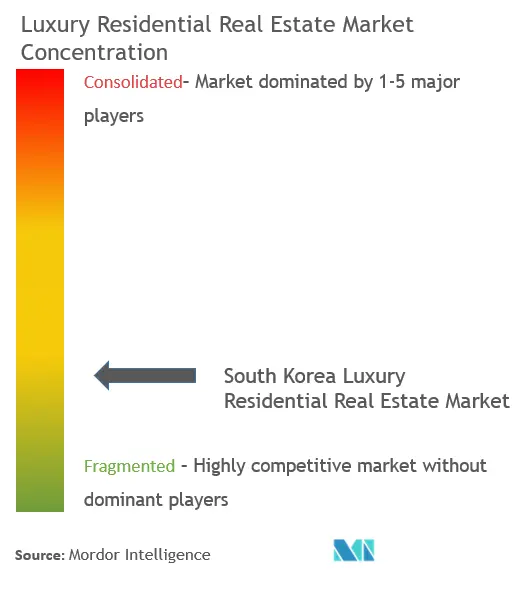
South Korea Luxury Residential Real Estate Market News
August 2023: A new development project calls for turning the Songdo International City R2 Block of the Incheon Free Economic Zone (IFEZ) into a "K-Contents City," according to local sources. As a shareholder in this development project, HYBE will see the construction of multiple expansive residential complexes throughout the city.
September 2023: South Korea's real estate landscape as it comes to light that a mere 30 individuals have managed to acquire a staggering 8,000 homes in the country over the past five and a half years. These eyebrow-raising acquisitions, totaling nearly INR 7,446 crore (USD 0.89 billion), have raised concerns and questions about the state of the housing market and the potential implications for average citizens.
South Korea Luxury Residential Real Estate Market Report - Table of Contents
1. INTRODUCTION
- 1.1 Study Assumptions
- 1.2 Scope of the Study
2. RESEARCH METHODOLOGY
- 2.1 Analysis Method
- 2.2 Research Phases
3. EXECUTIVE SUMMARY
4. MARKET INSIGHTS DYNAMICS
- 4.1 Current Market Scenario
-
4.2 Market Dynamics
- 4.2.1 Drivers
- 4.2.1.1 South Korea's status as a global business hub can attract expatriates and foreign executives seeking high-end accommodation options
- 4.2.1.2 Incorporating advanced technology and smart home features making luxury properties more appealing to tech-savvy buyers
- 4.2.2 Restraints
- 4.2.2.1 Lack of foreign investment
- 4.2.2.2 Stricter government regulation inhibiting the growth
- 4.2.3 Opportunities
- 4.2.3.1 Development of more sustainable and more eco-friendly homes
- 4.2.3.2 The introduction of smart of technology
- 4.3 Value Chain / Supply Chain Analysis
-
4.4 Industry Attractiveness - Porter's Five Forces Analysis
- 4.4.1 Bargaining Power of Suppliers
- 4.4.2 Bargaining Power of Buyers/Consumers
- 4.4.3 Threat of New Entrants
- 4.4.4 Threat of Substitute Products
- 4.4.5 Intensity of Competitive Rivalry
- 4.5 Industry Policies and Regulations
- 4.6 Technological Developments in the Sector
- 4.7 Impact of COVID-19 on the Market
5. MARKET SEGMENTATION
-
5.1 By Type
- 5.1.1 Apartments and Condominiums
- 5.1.2 Villas and Landed Houses
-
5.2 By City
- 5.2.1 Seoul
- 5.2.2 Busan
- 5.2.3 Other Cities
6. COMPETITIVE LANDSCAPE
- 6.1 Market Concentration Overview
-
6.2 Company Profiles
- 6.2.1 Samsung C&T Corporation
- 6.2.2 Daewoo Engineering & Construction
- 6.2.3 KyeRyong Construction Industrial
- 6.2.4 Hoban Construction
- 6.2.5 DL Construction
- 6.2.6 Daebang Construction
- 6.2.7 Ssangyong Engineering & Construction
- 6.2.8 Dongbu Corporation
- 6.2.9 Bando Engineering & Construction
- 6.2.10 Hyosung Heavy Industries*
- *List Not Exhaustive
7. FUTURE OF THE MARKET
8. APPENDIX
** Subject To AvailablitySouth Korea Luxury Residential Real Estate Industry Segmentation
Real estate is deemed "luxury" when it includes a desirable location, a high asking price, a substantial size, priceless materials, professional design, upscale facilities, and a distinguished past. Luxury real estate often includes a valuation that falls among the top 10% of houses on the local market. The report covers a complete background analysis of the South Korean luxury residential real estate market. It includes the economic assessment and sector contribution to the economy, market overview, market size estimation for key segments, emerging market segments, market dynamics, geographical trends, and COVID-19 impact.
The South Korean luxury residential real estate market is segmented by type (apartments and condominiums, villas, and landed houses) and cities (Seoul, Busan, and other cities).
The report offers the South Korean luxury residential real estate market size and forecasts in value (USD) for all the above segments.
| By Type | Apartments and Condominiums |
| Villas and Landed Houses | |
| By City | Seoul |
| Busan | |
| Other Cities |
South Korea Luxury Residential Real Estate Market Research FAQs
How big is the South Korea Luxury Residential Real Estate Market?
The South Korea Luxury Residential Real Estate Market size is expected to reach USD 43.56 billion in 2024 and grow at a CAGR of 10% to reach USD 70.18 billion by 2029.
What is the current South Korea Luxury Residential Real Estate Market size?
In 2024, the South Korea Luxury Residential Real Estate Market size is expected to reach USD 43.56 billion.
Who are the key players in South Korea Luxury Residential Real Estate Market?
Samsung C&T Corporation, Daewoo Engineering & Construction, KyeRyong Construction Industrial, Hoban Construction and DL Construction are the major companies operating in the South Korea Luxury Residential Real Estate Market.
What years does this South Korea Luxury Residential Real Estate Market cover, and what was the market size in 2023?
In 2023, the South Korea Luxury Residential Real Estate Market size was estimated at USD 39.20 billion. The report covers the South Korea Luxury Residential Real Estate Market historical market size for years: 2019, 2020, 2021, 2022 and 2023. The report also forecasts the South Korea Luxury Residential Real Estate Market size for years: 2024, 2025, 2026, 2027, 2028 and 2029.
South Korea Luxury Residential Real Estate Industry Report
Statistics for the 2024 South Korea Luxury Residential Real Estate market share, size and revenue growth rate, created by Mordor Intelligence™ Industry Reports. South Korea Luxury Residential Real Estate analysis includes a market forecast outlook 2029 and historical overview. Get a sample of this industry analysis as a free report PDF download.



